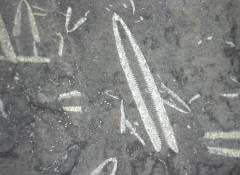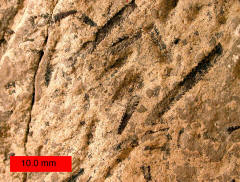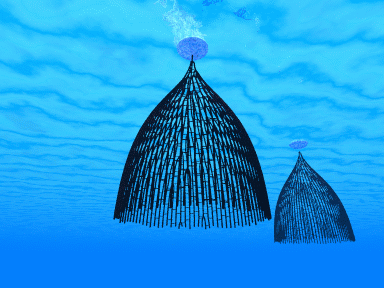|
Taxonomy
The name
originates from the genus Graptolithus, which was used by
Linneus
in 1735 for inorganic
mineralizations and
crustations which resembled actual fossils. In 1768, in the 12th volume of
Systema Naturae, he
included G. sagittarius and G. scalaris, respectively a possible
plant
fossil and a possible graptolite. In his 1751 Skånska Resa, he included a
figure of a "fossil or graptolite of a strange kind" currently thought to be
a type of Climacograptus (a
genus
of biserial graptolites). Later workers used the name to refer to a specific
group of organisms. Graptolithus was officially abandoned in 1954 by the
ICZN, partly because
of its original purpose as a grouping for inorganic mimicries of fossils.
(Bulman, 1970: V 6)
Since the 1970s, as a result of advances in
electron microscopy,
graptolites have generally been thought to be most closely allied to the
pterobranchs, a rare
group of modern marine animals belonging to the
phylum
Hemichordata (hemichordates).
Comparisons are drawn with the modern hemichordates
Cephalodiscus and
Rhabdopleura.
Cephalodiscus numbers about 18 species, and was first discovered in 1882.
Graptolites as Index Fossils
 |
|
Didymograptus murchisoni, a graptolite
from the Ordovician period.
(Picture
Source)
|
Graptolites are common fossils and have a worldwide distribution. The
preservation, quantity and gradual change over a geologic time scale of
graptolites allows the fossils to be used to date strata of rocks throughout
the world. They are important
index fossils for dating
Palaeozoic rocks as they evolved rapidly
with time and formed many different species. British geologists can divide
the rocks of the Ordovician and Silurian periods into graptolite biozones;
these are generally less than one million years in duration. A worldwide ice
age at the end of the Ordovician eliminated the majority of the then-living
graptolite; species present during the Silurian period were the result of
diversification from only a one or two species that survived the Ordovician
glaciation.
Graptolites are also used to estimate water
depth and temperature during the graptolites lifetimes.
Morphology
Each
graptolite colony is known as a rhabdosome and has a
variable number of branches (called
stipes)
originating from an initial individual (called a
sicula).
Each subsequent individual (zooid)
is housed within a tubular or cup-like structure (called a
theca).
In some colonies, there are two sizes of theca, and it has been suggested
that this difference is due to
sexual dimorphism.
The number of branches and the arrangement of the thecae are important
features in the identification of graptolite fossils. Their general shape
has been compared with that of a hacksaw blade.
Most of the dendritic or
many-branched types are classified as dendroid graptolites (order
Dendroidea). They appear earlier in the fossil record (in the Cambrian
period), and were generally benthic animals (attached to the sea-floor by a
root-like base). Graptolites with relatively few branches were derived from
the dendroid graptolites at the beginning of the Ordovician period. This
latter type (order Graptoloidea) were pelagic, drifting freely on the
surface of ancient seas or attached to floating seaweed by means of a
slender thread. They were a successful and prolific group, being the most
important animal members of the plankton until they died out in the early
part of the Devonian period. The dendroid graptolites survived until the
Carboniferous period.
Preservation
 |
| |
Graptolite fossils are often found in
shales
and mud rocks where sea-bed fossils are rare, this type of rock having
formed from sediment deposited in relatively deep water that had poor bottom
circulation, was deficient in oxygen, and had no scavengers. The dead
planktonic graptolites, having sunk to the sea-floor, would eventually
become entombed in the sediment and are thus well preserved.
Graptolites are also found in
limestones and
cherts,
but generally these rocks were deposited in conditions which were more
favorable for bottom-dwelling life, including scavengers, and undoubtedly
most graptolite remains deposited here were generally eaten by other
animals.
Graptolite fossils are often found flattened along the bedding plane of the
rocks in which they occur, though may be found in three dimensions when they
are infilled by
iron
pyrite.
They vary in shape, but are most commonly
dendritic or branching (such as
Dictoyonema), saw-blade like, or "tuning fork" shaped (such as Didymograptus
murchisoni). Their remains may be mistaken for fossil plants by the casual
observer.
Graptolites are
normally preserved as a black
carbonized film on the rock's surface or as
light grey clay films in
tectonically distorted rocks. They may be
sometimes difficult to see, but by slanting the specimen to the light they
reveal themselves as a shiny marking. Pyritized graptolite fossils are also
found.
End of Reading

Return to the
Old Earth Ministries Online Earth
History Curriculum homepage.

Source:
Graptolites
|


